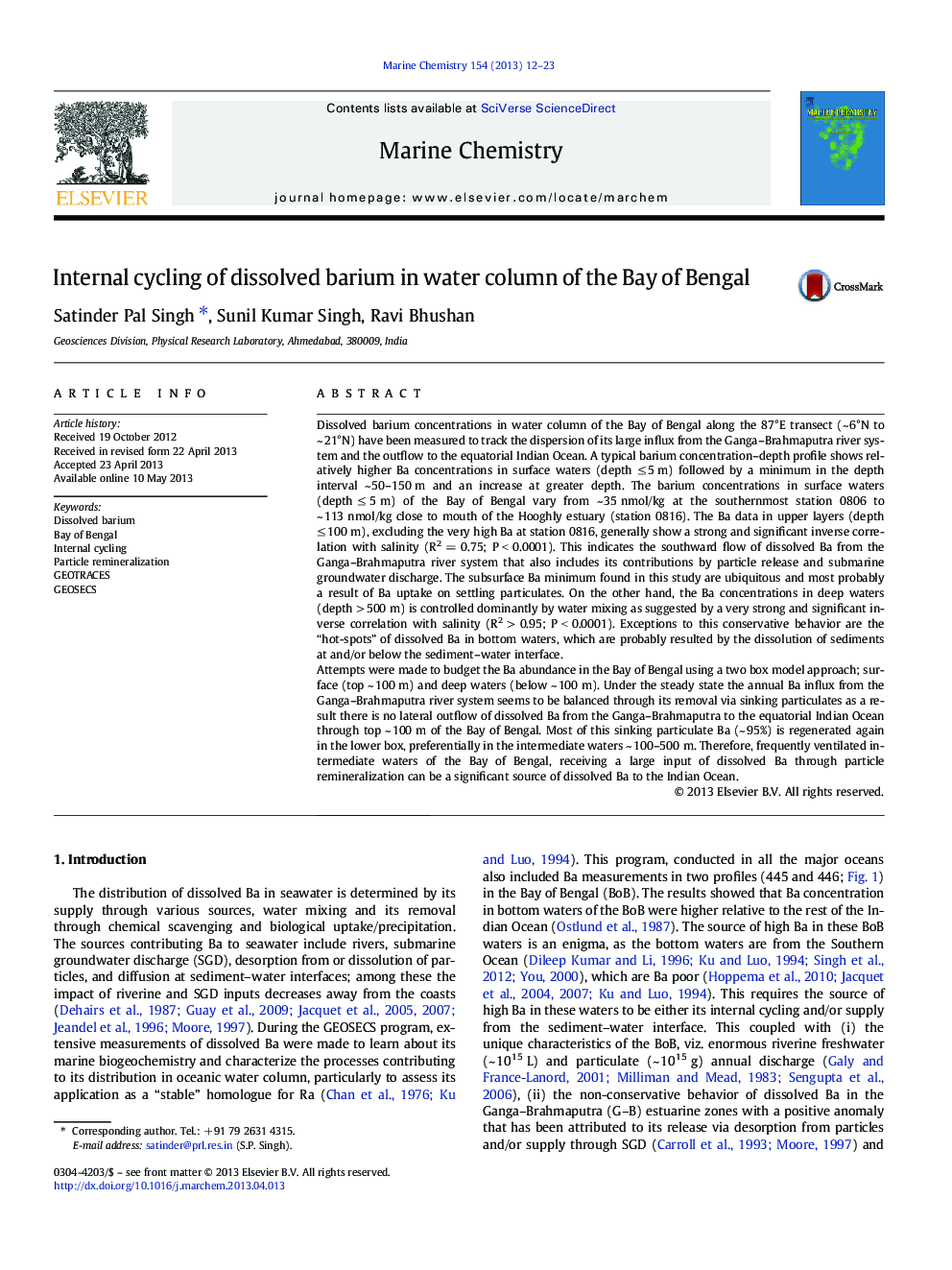| کد مقاله | کد نشریه | سال انتشار | مقاله انگلیسی | نسخه تمام متن |
|---|---|---|---|---|
| 1261415 | 1496681 | 2013 | 12 صفحه PDF | دانلود رایگان |

• Dissolved Ba in surface waters of the Bay of Bengal shows a North–South gradient.
• The Ganga–Brahmaputra controls Ba distribution in the surface waters of BoB.
• Large Ba influx from G–B seems to leave surface layer (top ~ 100 m) through sinking particles.
• About 95% of sinking particulate Ba re-dissolves preferentially at depth ~ 100–500 m.
Dissolved barium concentrations in water column of the Bay of Bengal along the 87°E transect (~ 6°N to ~ 21°N) have been measured to track the dispersion of its large influx from the Ganga–Brahmaputra river system and the outflow to the equatorial Indian Ocean. A typical barium concentration–depth profile shows relatively higher Ba concentrations in surface waters (depth ≤ 5 m) followed by a minimum in the depth interval ~ 50–150 m and an increase at greater depth. The barium concentrations in surface waters (depth ≤ 5 m) of the Bay of Bengal vary from ~ 35 nmol/kg at the southernmost station 0806 to ~ 113 nmol/kg close to mouth of the Hooghly estuary (station 0816). The Ba data in upper layers (depth ≤ 100 m), excluding the very high Ba at station 0816, generally show a strong and significant inverse correlation with salinity (R2 = 0.75; P < 0.0001). This indicates the southward flow of dissolved Ba from the Ganga–Brahmaputra river system that also includes its contributions by particle release and submarine groundwater discharge. The subsurface Ba minimum found in this study are ubiquitous and most probably a result of Ba uptake on settling particulates. On the other hand, the Ba concentrations in deep waters (depth > 500 m) is controlled dominantly by water mixing as suggested by a very strong and significant inverse correlation with salinity (R2 > 0.95; P < 0.0001). Exceptions to this conservative behavior are the “hot-spots” of dissolved Ba in bottom waters, which are probably resulted by the dissolution of sediments at and/or below the sediment–water interface.Attempts were made to budget the Ba abundance in the Bay of Bengal using a two box model approach; surface (top ~ 100 m) and deep waters (below ~ 100 m). Under the steady state the annual Ba influx from the Ganga–Brahmaputra river system seems to be balanced through its removal via sinking particulates as a result there is no lateral outflow of dissolved Ba from the Ganga–Brahmaputra to the equatorial Indian Ocean through top ~ 100 m of the Bay of Bengal. Most of this sinking particulate Ba (~ 95%) is regenerated again in the lower box, preferentially in the intermediate waters ~ 100–500 m. Therefore, frequently ventilated intermediate waters of the Bay of Bengal, receiving a large input of dissolved Ba through particle remineralization can be a significant source of dissolved Ba to the Indian Ocean.
Journal: Marine Chemistry - Volume 154, 20 August 2013, Pages 12–23